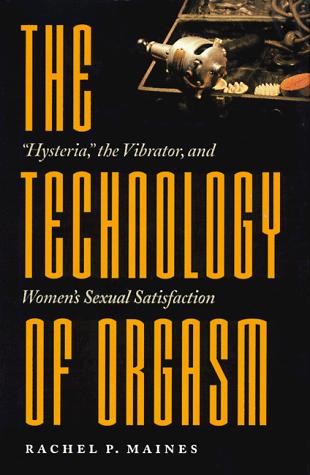Rachel P. Maines: The Technology of Orgasm: “Hysteria”, the Vibrator, and Women’s Sexual Satisfaction (2001)
Filed under book | Tags: · advertising, history of technology, hysteria, sex, technology, vibrator, women

From the time of Hippocrates until the 1920s, massaging female patients to orgasm was a staple of medical practice among Western physicians in the treatment of “hysteria,” an ailment once considered both common and chronic in women. Doctors loathed this time-consuming procedure and for centuries relied on midwives. Later, they substituted the efficiency of mechanical devices, including the electric vibrator, invented in the 1880s. In The Technology of Orgasm, Rachel Maines offers readers a stimulating, surprising, and often humorous account of hysteria and its treatment throughout the ages, focusing on the development, use, and fall into disrepute of the vibrator as a legitimate medical device.
Publisher JHU Press, 2001
Johns Hopkins studies in the history of technology
ISBN 0801866464, 9780801866463
208 pages
PDF (no OCR; updated on 2012-10-23)
Comment (0)nØ1se exhibition catalogue (2000)
Filed under catalogue | Tags: · art, computing, history of computing, history of technology, media art, noise, robotics, science, technology

Catalogue for the multi-site multimedia exhibition in Cambridge and London (January-May 2000), devised by artist, Adam Lowe, and, historian of science, Simon Schaffer, and organised around three key themes in “digitality”:
Universal Language
Pattern Recognition
Data Synæsthetics
nØ1se is not limited to electronic media, but traces the digital imagination from such myths as Noah’s Ark, through the early modern experiments of Charles Babbage’s Difference Engine and Morse’s Telegraph, up to today’s charge coupled devices (CCDs), robotics and beyond.. It highlights digitality in history, technology, art and science, drawing upon a wide range of objects and images from artists and scientists around the globe — everything from 3000BC artefacts to the latest state-of-the-art pictures of the surface of atoms.
Catalogue contributors: Tabatha Andrews, William Armstrong, Art and Language, Charles Babbage, Stephen Baker, Joe Banks, Richard Barbrook, William Bateson, Evgen Bavcar, Robin Boast, Patrick Blackett, Jerry Brotton, Soraya de Chadarevian, Adrian Cussins, Su Dalgleish, John Dee, Umberto Eco, Richard Feynman, Manuel Franquelo, Peter Galison, Joy Garnett, Merrill Garnett, Joseph Grigely, Roger Guillemin, Sebastian Guillié, Mercurius Van Helmont, Lynn Hershman, Jeff Hughes, Margaret Watts Hughes, Lisa Jardine, Bill Jones, Athanasius Kircher, Bruno Latour, Malcom Longair, Mike Lynch, Paul D Miller (aka DJ Spooky), Iwan Morus, Gracie Ngale Morton, Sven Nebel, Joseph Nechvatal, Ben Neill, Pictic Balls, Roy Porter, Marc Quinn, Jonathan Ree, Michael Rees, Giles Revell, Kathleen Rogers, Romandson, Brian Rotman, Stan Vanderbeek, Tom Van Sant, Ludwig Von Siegen, Julian Simmons, Nicola Schwartz, Lillian Schwartz, Robert Shannon, Bessie Nakamarra Sims, Paddy Japaljarri Sims, Brian Cantwell Smith, Luc Steels, Bruce Sterling, Jozue Tanaka, John Tchalenko, Dave Tovee, John Tresch, Burhan Tufail, John Tresch, Catherine Wagner, Piers Wardle, Peter Weibel, CTR Wilson, John Wilkins, John Woodward, Charles Wynn-Williams.
Edited by Alfred Birnbaum
Conceived of and designed by Adam Lowe
Published by Kettle’s Yard, Cambridge UK, 2000
ISBN: 0907074782, 978-0907074786
118 pages
View online (Section 1; HTML articles)
View online (Section 2; HTML articles)
View online (Section 3; HTML articles)
Steven T. Usdin: Engineering Communism: How Two Americans Spied for Stalin and Founded the Soviet Silicon Valley (2005)
Filed under book | Tags: · communism, computing, engineering, history of computing, history of technology, intelligence agency, soviet union, technology

Engineering Communism is the fascinating story of Joel Barr and Alfred Sarant, dedicated Communists and members of the Rosenberg spy ring, who stole information from the United States during World War II that proved crucial to building the first advanced weapons systems in the USSR. On the brink of arrest, they escaped with KGB’s help and eluded American intelligence for decades.
Drawing on extensive interviews with Barr and new archival evidence, Steve Usdin explains why Barr and Sarant became spies, how they obtained military secrets, and how FBI blunders led to their escape. He chronicles their pioneering role in the Soviet computer industry, including their success in convincing Nikita Khrushchev to build a secret Silicon Valley.
The book is rich with details of Barr’s and Sarant’s intriguing andexciting personal lives, their families, as well as their integration into Russian society. Engineering Communism follows the two spies through Sarant’s death and Barr’s unbelievable return to the United States.
Publisher Yale University Press, 2005
ISBN 0300108745, 9780300108743
329 pages
PDF (images missing; updated on 2012-7-25)
Comment (1)
